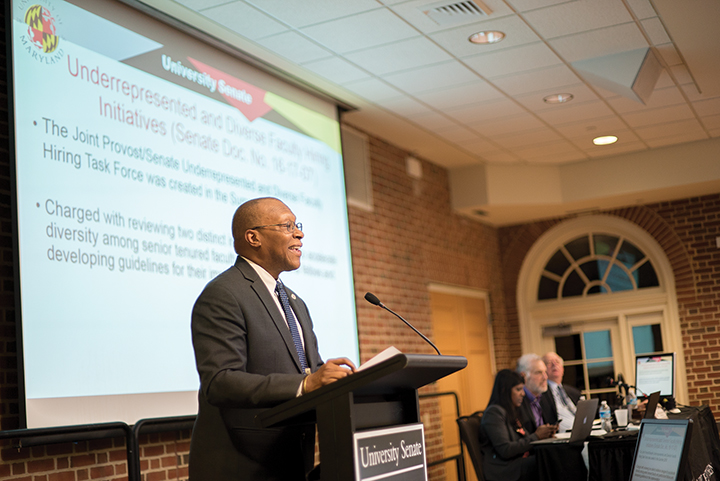To help diversify a campus where about two-thirds of tenure-track or tenured faculty members are white, the University Senate supported a special report Thursday analyzing the diversity of these University of Maryland faculty members and creating guidelines for two new programs to help bring in more diverse teachers.
The proposal was split into two votes: one for recommended guidelines for a new post-doctoral research program and one for a new senior faculty hiring initiative. The postdoc program guidelines passed 105-13, with five abstentions. The senior hiring initiative passed 98-14, with four abstentions.
The task force that put together the report was a joint effort by the Provost’s Office and the University Senate. It met throughout the summer and finished its report in September. Stephen Thomas, director of the Maryland Center for Health Equity, chaired the task force and presented the report to the Senate on Thursday.
“We have an institutional plan that I believe will make a historic difference here at the university,” Thomas said.
The task force recommended guidelines for a new postdoctoral program called the President’s Postdoctoral Fellowship Program. The program, which is part of a collaborative effort this university joined earlier this year with the University of California, hopes to eventually increase the number of top faculty members that come from underrepresented groups by recruiting diverse graduates to become postdocs and enter the career path to becoming a professor.
The report suggested that the program highlight its prestige and create a mentor program for the selected fellows, pairing them with tenured faculty members.
Richard Payne, a biology professor and senator, emphasized the need to prepare postdocs for the struggle it can be to get hired after their time as a postdoc is over.
“It’s a tough thing to do, and I wonder if you really want people coming in to face that atmosphere,” Payne said. “It’s going to require very talented mentoring from the whole faculty to make that happen.”
The task force also recommended an initiative to hire diverse senior faculty, where any college at this university can submit a proposal to the Provost’s Office to hire “outstanding senior faculty from underrepresented populations.” This program would have the Provost’s Office “providing a substantial contribution of the funding” along with money from the specific college and unit making the hire, according to the report.
The report did not provide an exact financial commitment that the Provost’s Office would give to support these programs.
“I’m not convinced that it’s the most cost-effective or more generally effective way of improving the diversity of the campus,” said Joshua Singer, a biology professor. “Hiring people who have already made it, I don’t think serves many goals other than hiring good people.”
Thomas responded by stating that the presence of diverse faculty members has a tremendous impact and benefit to this university.
School-wide, 68 percent of tenure-track or tenured faculty members were white, 15 percent were Asian, 5 percent were black and 4 percent were Hispanic. Eight percent were unreported, according to the report, which provided data as of spring 2016.
The report also included information on each individual college for diversity in tenure-track or tenured faculty as of last spring. The least diverse school was the Philip Merrill College of Journalism, with 92 percent of such faculty reported as white and 8 percent as Asian. The Robert H. Smith School of Business fared the best in regard to most non-white faculty with 39 percent non-white.
Data compiled by the task force also shows little to no progress in the last five years on the male-female split among tenure or tenure-track faculty. In 2011, the gender split among professors was 78 percent male and 22 percent female. For the 2016-17 year, those figures were 76 percent male and 24 percent female.
However, this university has made more progress among assistant professors in that time frame, going from a male-female ratio of 57-43 in 2011 to 52-48 for the 2016-17 year.
This university appears to be slightly ahead of the nationwide situation on diversifying in regard to race, while trailing behind on gender, according to a nationwide analysis on fall 2013 by the U.S. Department of Education’s National Center for Education Statistics. That analysis showed 84 percent of professors were white for fall 2013, 3 percent were black, 3 percent were Hispanic and 9 percent were Asian. It also showed 69 percent of professors were male for fall 2013, while that figure remains upwards of 75 percent at this university for 2016-17.
Now supported by the University Senate, the proposal awaits university President Wallace Loh’s approval before becoming school policy.



